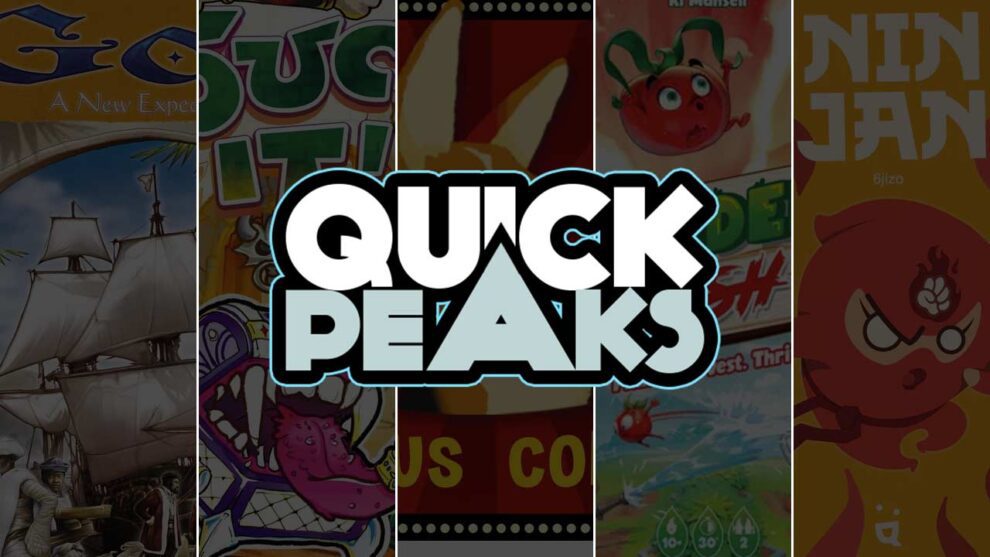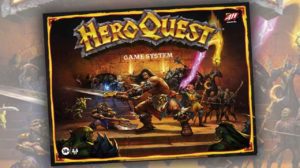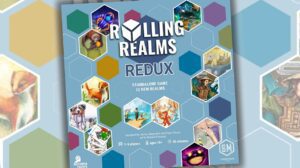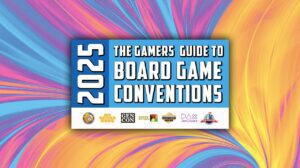Goa: A New Expedition – Justin Bell
My buddy Jacob had been trying to get Goa: A New Expedition to the table for the last couple of weeks, so a group of us jumped in for a play at a recent game night. Goa, designed by one of my favorites, Rüdinger Dorn (the man who gave us Istanbul and Luxor) is an auction and resource management game set in a time period that is best described by our colleague Thomas Wells as, well, “uncomfortable.” Like a lot of older Eurogame designs—Goa, first published in 2004, is out of print—one has to really work to look past the subject matter, but if you are able, Goa does a lot of things really well from a gameplay perspective.
The game takes place over eight rounds, as players try to maximize their five-column production engine to score the most points. The mechanics in each round are first tied to a fun auction system, where all players use bidding tokens to claim ownership of a tile that will later be placed for bid and sold to the highest bidder, which might even be the player who started that auction. The back half of each round is a bit more rote, with players producing “expedition” cards to activate special powers, harvests to produce goods, and ships to move goods around the world. There’s also a colonize action that is used to expand goods storage and score a bounty of end-game points. (In our lowest moment of this first play, one guy noted that he needed to optimize his “colonization engine.” Older Euros, my friends!)
We got a number of rules wrong in this first play, leading to a playtime of nearly two-and-a-half hours. But the auction mechanics—now that we have it down—are excellent and that led to a ton of drama on every turn, especially in a game where money is secret. (The jury is still out on whether the money is secret, or hidden, because money in this game is represented by cards of varying values.) While the turn-taking in the back half of each round was nothing to write home about, I’m intrigued enough about Goa to try it again in the next few weeks, while the rules are still fresh in my head.
Ease of entry?
★★☆☆☆ – Not an easy onboard
Would I play it again?
★★★★☆ – Would like to play it again
Read more articles from Justin Bell.
Touch It! – Kevin Brantley
Touch it. No, seriously, touch it.
This zany experience plays more like a group activity than an actual game. This stocking-stuffer of a game is most likely targeted at children, as they’ll probably get more of a kick out of this sensory adventure from the Wonderful World Board Games.
Players draw from a mutual deck without looking at or touching the back of the card. The front of the card features four drawings of what the object on the back could be. On the count of three, players simultaneously feel around the back to guess what their object is. Players quickly announce “Got it!” and put their card down, with the round ending once only one player remains. Players score one point for a correct guess and an extra point if they are the fastest to guess correctly. The first to reach seven points has the best touch.
This is more of a bar game—it’s silly, quick, and easy to teach. But is it fun? Eh. I can’t imagine a scenario where I’d ever choose to break this game out over the myriad of other quick dexterity games. While it is funny to see your absolutely certain guess turn out to be completely incorrect, the experience feels very lukewarm. Sometimes patience pays off—many times, the winner was simply the player who guessed last, benefiting from everyone else’s overeagerness, leading to incorrect answers. This often resulted in the last player also earning the bonus “first correct” point. Fortunately, the game is over in about five minutes, so you can quickly move on.
That said, this would be a great experience with young kids. Even without keeping score, it’s a fun activity to break out with little nieces and nephews at family gatherings. The variety of imagery makes each round an entertaining guessing game for little ones. Touch It also comes in different versions (Marine Life, Pop Culture, Japan, etc.). I played with the Dungeon version, which has an added bonus—the images are accompanied by stats, encouraging their use as encounter cards in tabletop RPGs. A nice touch.
Ease of entry?:
★★★★★ – No sweat. Just touch and tell.
Would I play it again?:
★☆☆☆☆ – Would play again but will cry about it
Read more articles from Kevin Brantley.
Circus Corgis – Kevin Brantley
I had the pleasure of picking up this small but mighty trick-taking game at PAX U’s Indie Market last year. For those who are not familiar, this market features indie publishers who can sell their (often hand-produced) games without any fees. It’s a fantastic opportunity to expose indie games to a large audience.
This game comes in a small Altoids-sized tin from Zerua Games. Sidebar—I have a corgi named Oberon, so the theme grabbed me instantly.
This adorable circus of corgis puts players head-to-head in a standard trick-taking game with the added element of betting. Players bet on either the specific number of tricks they’ll win that round or a range (e.g., 0-2, 3-5, etc.). If players are correct, they score a trophy (or two if they impressively guess the exact number), and the first to four or five trophies is the champion corgi.
One added twist is that low cards can be played as high values if players pay a “treat” token. These are extremely limited and can only be obtained by correctly guessing tricks, so timing is crucial.
Trick-taking games have taken the industry by storm over the last couple of years. It makes sense—it’s a fun and easy concept that allows for creative thematic twists. The challenge comes in making a game stand out in a sea of others. Circus Corgis stands out thanks to its mechanics of paying to boost values and betting on ranges in addition to specific numbers.
There’s plenty of high-stakes drama to be had when someone skunks your streak and forces you to take one extra trick, pushing you over your bet. The components are impressive, with chunky wooden pieces and linen cards, all fitting into a tin box that you can carry in your pocket. It’s a fresh take on trick-taking, combining a variety of mechanics that put these corgos toward the front of the pack.
Ease of entry?:
★★★★☆ – The odd bump or two
Would I play it again?:
★★★★☆ – Would like to play it again
Read more articles from Kevin Brantley.
Garden Rush – David McMillan
Garden Rush is a tile-drafting, pattern-matching game in which players are racing to plant and harvest crops in order to score 40 points before their opponent. Each player has their own gridded garden plot. In between these is the Harvest row, which is populated with vegetable tiles drawn from a bag. Each plot of the Harvest row is paired with a specific column on a player’s garden plot.
On a player’s turn, they can either take a tile from the Harvest row and place it into their garden plot double-icon side up (if it’s placed in the same column from which it was taken) or single-side up (if placed in a different column) OR they may choose to harvest a veggie bed in order to score points. Each vegetable type scores for groups of that type placed into the garden in specific patterns. To score a veggie bed, simply remove the group from your board and score points equal to the number of tiles removed—with one caveat: double-icon tiles get flipped to their single-icon side instead of being removed, allowing you to hang on to them for later scoring. Additionally, there are some icons printed on the garden plots that, when covered, will provide the player with special abilities.
For such a small, simple game, there’s a lot to consider when deciding which vegetables to take and where to place them. I really enjoyed my first play of the game. There were several times where I was able to chain various effects together in order to pull off some very satisfying combos. It’s also worth noting that the box itself serves as the game and scoring board, creating a pleasant, challenging, and compact experience that easily fits into my backpack.
Keep your eyes peeled for my forthcoming review of Garden Rush!
Ease of entry?
★★★★★ – No sweat
Would I play it again?
★★★★★ – Will definitely play it again
Ninjan – Andy Matthews
I always find it interesting when someone sets out to make a “better version” of an old game. There are countless “chess killer” or “better than checkers” games. These are static targets because they’re so well known. Another popular target: rock paper scissors. But these games have survived for a number of reasons: they’re really good (chess), they’re simple (checkers), or they’re useful (rock paper scissors). Each of these games is still around because of one (or more) of those reasons.
So when I was given Ninja, by Helvetiq, as a review copy I wasn’t sure what to think. The presentation is whimsical and cute: Helvetiq (like Oink Games) delights in small box goodness, many of which are fantastic (Tucano, Bandido / Bandida, and Kariba to name a few). The game on the other hand, is just so-so. Perhaps it was the player count—just 2 players even though the box says 2-5—or the fact that we didn’t “get” the point, but my son and I were underwhelmed. We finished our play and just put everything back in the box in silence.
Ninjan is a rare miss from Helvetiq. Their games have always punched above their weight, and I was expecting at least a few kicks out of this small orange box. But instead; Ninjan dropped a smoke bomb and disappeared from sight, and from our memories.
Ease of entry?
★★☆☆☆ – Not an easy onboard
Would I play it again?
★☆☆☆☆ – Would play again but will cry about it













Add Comment